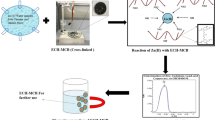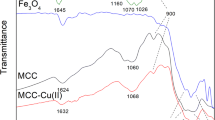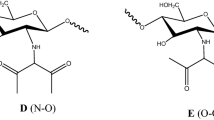Abstract
One of the major concerns of mining companies is the safety of their tailing dams. Among the cares required to operate such a dam, a proper treatment of the effluent composing its waste stands out, since that, waste must be treated before returned to the environment. In the process of bauxite beneficiation, the effluent level of turbidity is the discard parameter that deserves attention. In this work, quaternized chitosan (TMCCl−) derivative with cationic charge was synthetized and investigated to be used as coagulant in bauxite treatment for tailing dam effluent. The chitosan (CHT) was quaternized by methylation reaction. The quaternized chitosan structure was characterized by the following techniques: FTIR Spectroscopy and 1H nuclear magnetic resonance (NMR). Its thermal stability was analyzed by differential scanning calorimetry (DSC) and thermogravimetric analysis. After quaternized chitosan was obtained, analysis with aluminum sulfate, protonated and quaternized chitosan were executed in jar-test apparatus. The tests were conducted in order to find the optimum pH, velocity gradient, coagulant and alkalizer dosages, as well as coagulation, flocculation and decantation time. The studied coagulants showed good results and reduced the effluent turbidity to levels below determined by legislation. By comparing the coagulants, it was possible to state that quaternized chitosan presented higher reduction of effluent turbidity levels; the tests were performed in the same conditions.








Similar content being viewed by others
References
Silva OP (1995) A mineração em minas gerais: passado, presente e futuro. Geonomos 3(1):77–86
Gomes CM, Kneipp JM, Kruglianskas I, Rosa LAB, Bichueti RS (2013) Management for sustainability in companies of the mining sector: an analysis of the main factors related with the business performance. J Clean Prod 84:85–93
Robert T, Mercer SM, Clark TJ, Mariampillai BE, Champagne P, Cunningham MF, Jessop PG (2012) Nitrogen-containing polymers as potent ionogens for aqueous solutions of switchable ionic strength: application to separation of organic liquids and clay particles from water. Green Chem 14:3053
Roosen J, Roosendael SV, Borra CR, Gerven TV, Mullens S, Binnemans K (2015) Recovery of scandium from leachates of Greek bauxite residue by adsorption on functionalized chitosan–silica hybrid materials. Green Chem. https://doi.org/10.1039/C5GC02225H
Smith P (2009) The processing of high silica bauxites—review of existing potential processes. Hydrometallurgy 98:162–176
Klauber C, Gräfe M, Power G (2011) Bauxite residue issues: II. options for residue utilization. Hydrometallurgy 108:11–32
Pan JR, Huang C, Chen S, Chung Y (1999) Evaluation of a modified chitosan biopolymer for coagulation of colloidal particles. Colloids Surf A 147:359–364
Carpinteyro-Urban S, Torres LG (2013) Use of response surface methodology in the optimization of coagulation-flocculation of wastewaters employing biopolymers. Int J Environ Res 7(3):717–726
Nouri J, Mahvi AH, Bazrafshan E (2010) Application of electrocoagulation process in removal of zinc and copper from aqueous solutions by aluminum electrodes. Int J Environ Res 4(2):201–208
Zulfikar MA, Setiyanto H, Wahyuningrum D, Mukti RR (2014) Peat water treatment using chitosan-silica composite as an adsorbent. Int J Environ Res 8(3):687–710
Hu C, Lo S, Chang C, Chen F, Wu Y, Ma J (2013) Treatment of highly turbid water using chitosan and aluminum salts. Sep Purif Technol 104:322–326
Curti E, Britto D, Campana-Filho SP (2003) Methylation of chitosan with iodomethane: effect of reaction conditions on chemo selectivity and degree of substitution. Macromol Biosci 10(3):571–576
Lin J, Wang L, Wang L (2012) Coagulation of sericin protein in silk degumming wastewater using quaternized chitosan. J Polym Environ 20:858–864
Wang CH, Liu WS, Sun JF, Hou GG, Chen Q, Cong W, Zhao F (2016) Non-toxic O-quaternized chitosan materials with better water solubility and antimicrobial function. Int J Biol Macromol 84:418–427
Martins AF, Pereira AGB, Fajardo AR, Rubira AF, Muniz EC (2011) Characterization of polyelectrolytes complexes based on N, N, N-trimethyl chitosan/heparin prepared at different pH conditions. Carbohydr Polym 86:1266–1272
Mangala SA, Chalakkal IJ (1979) Infrared spectra of alkyl tri(methyl/[2H3]methyl)ammonium iodides. Characteristic rocking vibrations of—N+(CH3)3 group at 970–910 cm−1. J Chem Soc Faraday Trans 2 75:733–737
Mangala SA, Chalakkal IJ (1977) Characteristic vibrations of—N(CH3)2 and—N+(CH3)3 groups in dimethyl aminophenol’s and their methiodides. J Chem Soc Faraday Trans 2 73:1232–1237
Neto CGT, Giacometti JA, Job AE, Ferreira FC, Fonseca JLC, Pereira MR (2005) Thermal analysis of chitosan based networks. Carbohydr Polym 62:97–103
Rotta J, Minatti E, Barreto PLM (2011) Determination of structural and mechanical properties, diffractometry, and thermal analysis of chitosan and hydroxypropylmethylcellulose (HPMC) films plasticized with sorbitol. Ciênc Tecnol Aliment Campinas 31:450–455
Britto D, Campana-Filho SPA (2004) Kinetic study on the thermal degradation of N, N, N-trimethylchitosan. Polym Degrad Stab 84:353–361
Gonil P, Sajomsang W, Ruktanonchai UR, Pimpha N, Sramala I, Nuchuchua O, Saesoo S, Chaleawlert-Umpon S, Puttipipatkhachorn S (2011) Novel quaternized chitosan containing β-cyclodextrin moiety: synthesis, characterization and antimicrobial activity. Carbohydr Polym 83:905–913
Pardeshi CV, Belgamwar VS (2016) Controlled synthesis of N, N, N-trimethyl chitosan for modulated bioadhesion and nasal membrane permeability. Int J Biol Macromol 82:933–944
Patel P, Agrawal YK, Sarvaiya J (2015) Cyclodextrin based ternary system of modafinil: effect of trimethyl chitosan and polyvinylpyrrolidone as complexing agents. Int J Biol Macromol 84:182–188
Guinesi LS, Cavalheiro ETG (2006) The use of DSC curves to determine the acetylation degree of chitin/chitosan samples. Thermochem Acta 444:128–133
Sila A, Mlaik N, Sayari N, Balti R, Bougatef A (2014) Chitin and chitosan extracted from shrimp waste using fish proteases aided process: efficiency of chitosan in the treatment of unhairing effluents. J Polym Environ 22:78–87
Larsson A, Walldal C, Wall S (1999) Flocculation of cationic polymers and nanosized particles. Colloids Surf A 159:65–76
Di Bernardo L (Coord.) (2003) Tratamento de água para abastecimento por filtração direta. ABES, RiMa 114, 162, 498, Rio de Janeiro
Ndiongue S, Desjardins R, Prévost M (2000) The use of jar-filtration tests to compare performances of coagulants in direct filtration. Environ Technol 21:67–76
Acknowledgements
We would like to thank FAPERJ and CNPq for the financial support and the CBA/Votorantim for its technical collaboration.
Author information
Authors and Affiliations
Corresponding author
Ethics declarations
Conflict of interest
The authors declare that they have no conflict of interest.
Rights and permissions
About this article
Cite this article
Bigogno, R.G., Rodríguez, R.J.S. & Abreu, M.F. Quaternized Chitosan for Ecological Treatment of Bauxite Mining Effluents. J Polym Environ 26, 4169–4175 (2018). https://doi.org/10.1007/s10924-018-1289-1
Published:
Issue Date:
DOI: https://doi.org/10.1007/s10924-018-1289-1




